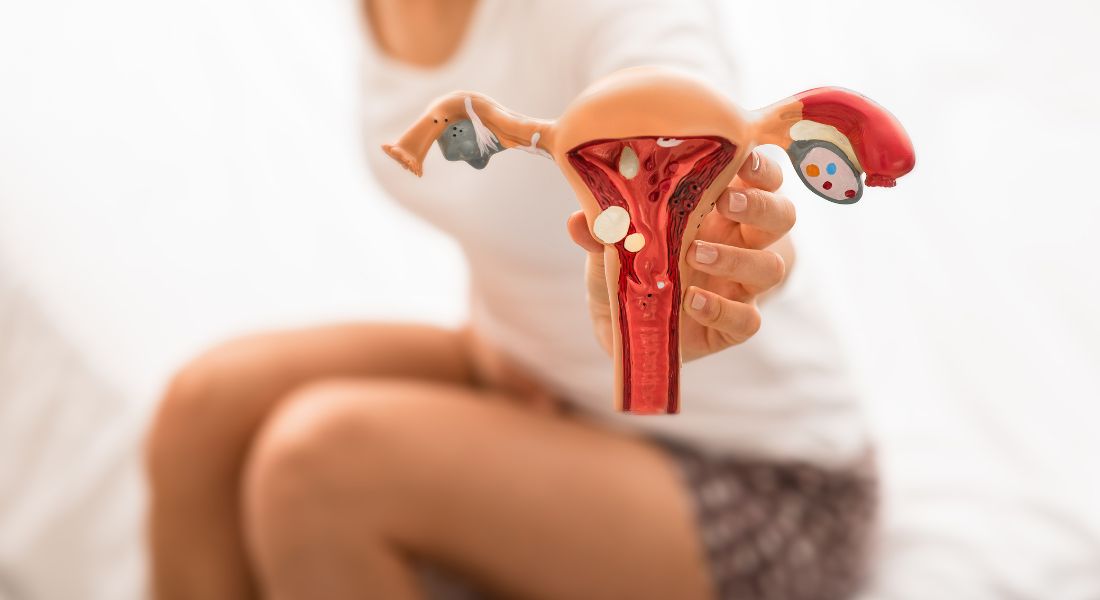Categories
Endometriosis - Diagnosis and Treatment
Oct 25, 2022
Endometriosis is a painful condition in which the endometrium, the tissue that usually lies inside the uterus, starts growing outside the uterus. It can involve ovaries, the tissue lining the pelvis, and the fallopian tubes. In rare cases, it can spread beyond the pelvic organs. Now, since this is an endometrial-like tissue, it will thicken, break down, and bleed with each menstrual cycle. But, unlike inside the uterus, it doesn’t have a way to exit the body. So, it gets trapped. When this involves the ovaries, it results in the formation of cysts called endometriomas. It can irritate the surrounding tissue and develop scar tissue.
Endometriosis can cause severe pain, especially during menstrual periods. Fortunately, there are effective treatments available for these conditions. But first, let’s learn how endometriosis is diagnosed: Diagnosis
In order to make a diagnosis, the doctor will ask you about your symptoms, the location and timing of the pain, etc. Then, they will perform tests for checking physical signs of endometriosis like: 1.Pelvic Exam -
In this exam, the doctor will manually feel the areas in the pelvis to check for abnormalities like scars behind the uterus or cysts on the reproductive organs. Sometimes, feeling small endometriosis areas is impossible unless a cyst has formed. 2.Ultrasound -
In this test, a specialist will use high-frequency sound waves for creating images of your body organs. A device called a transducer will be used for capturing the images by pressing it against the abdomen or inserting it inside the vagina. A standard ultrasound won’t confirm the presence of endometriosis, but it will definitely identify the cysts associated with the conditions. 3.Magnetic Resonance Imaging (MRI) -
In this exam, radio and magnetic field waves are used for creating detailed images of the tissues and organs inside the body. In some cases, it can help in surgical planning as well by giving the doctor exact information about the size and location of the endometrial implants. 4.Laparoscopy -
In this procedure, the surgeon is able to view inside the abdomen and look for any signs of endometrial tissue present outside the uterus. While the patient is under general anesthesia, the surgeon will insert a slender instrument called laparoscope inside the body through a tiny incision near the navel. Through this procedure, the surgeon is able to learn the extent, size and location of the endometrial implants. A small tissue sample will be taken for further testing. With the right surgical planning, the endometriosis can be treated during the laparoscopy as well so that the patient doesn’t have to go through another surgery. Treatment
Endometriosis treatment involves medications or surgery. Whatever approach is recommended by the doctor will depend on the security of the symptoms and whether the patient wants to become pregnant or not. In most cases, surgery is only recommended if the initial conservative treatments fail. Here are a few examples of such treatments: Pain medications
In order to ease painful cramps during the menstrual periods, the doctor might recommend some over-the-counter pain medications. If you aren’t trying to get pregnant, they might also recommend some hormone therapy along with pain relievers. Hormone Therapy
Supplemental hormones can be effective in eliminating or at least reducing the pain of endometriosis. During the menstrual cycle, when there are fluctuations in the hormone levels, the endometrial implants start thickening, breaking down, and bleeding. By taking hormone medications, the endometrial tissue’s growth can be slowed down and new endometrial tissue implants can be prevented. However, this isn’t a permanent fix and the symptoms will return once the treatment is stopped. Conservative surgery
If someone has this condition and they are trying to get pregnant, it is possible to remove the endometriosis implants while preserving ovaries and uterus. In case someone is going through severe pain because of this condition, surgery is a suitable option for them as well. However, there is a chance that pain and endometriosis might return. There are two ways to perform this procedure. The first one is the laparoscopic procedure and the second one is the traditional abdominal surgery. Even the most severe cases of endometriosis can be treated through the laparoscopic procedure. The latter one is performed in the most extensive cases. Endometriosis can result in trouble conceiving. If someone is trying to get pregnant and is experiencing difficulty, they must reach out to a fertility specialist to check if they have a problem and get appropriate treatment. The fertility treatment can range from making more eggs to stimulating the ovaries to in vitro fertilization. Whatever treatment is recommended will depend on their personal situation. Before starting the treatment, all the patients must know the available options and the possible outcomes. At BirthRight by Rainbow Hospitals, we offer online doctor consultation in Bangalore, so that you don’t have to leave the comfort and safety of your home. Through the video consultation online, our doctors will be able to provide you with the same high-quality treatment you would have gotten during the face-to-face appointment.
In order to ease painful cramps during the menstrual periods, the doctor might recommend some over-the-counter pain medications. If you aren’t trying to get pregnant, they might also recommend some hormone therapy along with pain relievers. Hormone Therapy
Supplemental hormones can be effective in eliminating or at least reducing the pain of endometriosis. During the menstrual cycle, when there are fluctuations in the hormone levels, the endometrial implants start thickening, breaking down, and bleeding. By taking hormone medications, the endometrial tissue’s growth can be slowed down and new endometrial tissue implants can be prevented. However, this isn’t a permanent fix and the symptoms will return once the treatment is stopped. Conservative surgery
If someone has this condition and they are trying to get pregnant, it is possible to remove the endometriosis implants while preserving ovaries and uterus. In case someone is going through severe pain because of this condition, surgery is a suitable option for them as well. However, there is a chance that pain and endometriosis might return. There are two ways to perform this procedure. The first one is the laparoscopic procedure and the second one is the traditional abdominal surgery. Even the most severe cases of endometriosis can be treated through the laparoscopic procedure. The latter one is performed in the most extensive cases. Endometriosis can result in trouble conceiving. If someone is trying to get pregnant and is experiencing difficulty, they must reach out to a fertility specialist to check if they have a problem and get appropriate treatment. The fertility treatment can range from making more eggs to stimulating the ovaries to in vitro fertilization. Whatever treatment is recommended will depend on their personal situation. Before starting the treatment, all the patients must know the available options and the possible outcomes. At BirthRight by Rainbow Hospitals, we offer online doctor consultation in Bangalore, so that you don’t have to leave the comfort and safety of your home. Through the video consultation online, our doctors will be able to provide you with the same high-quality treatment you would have gotten during the face-to-face appointment.











